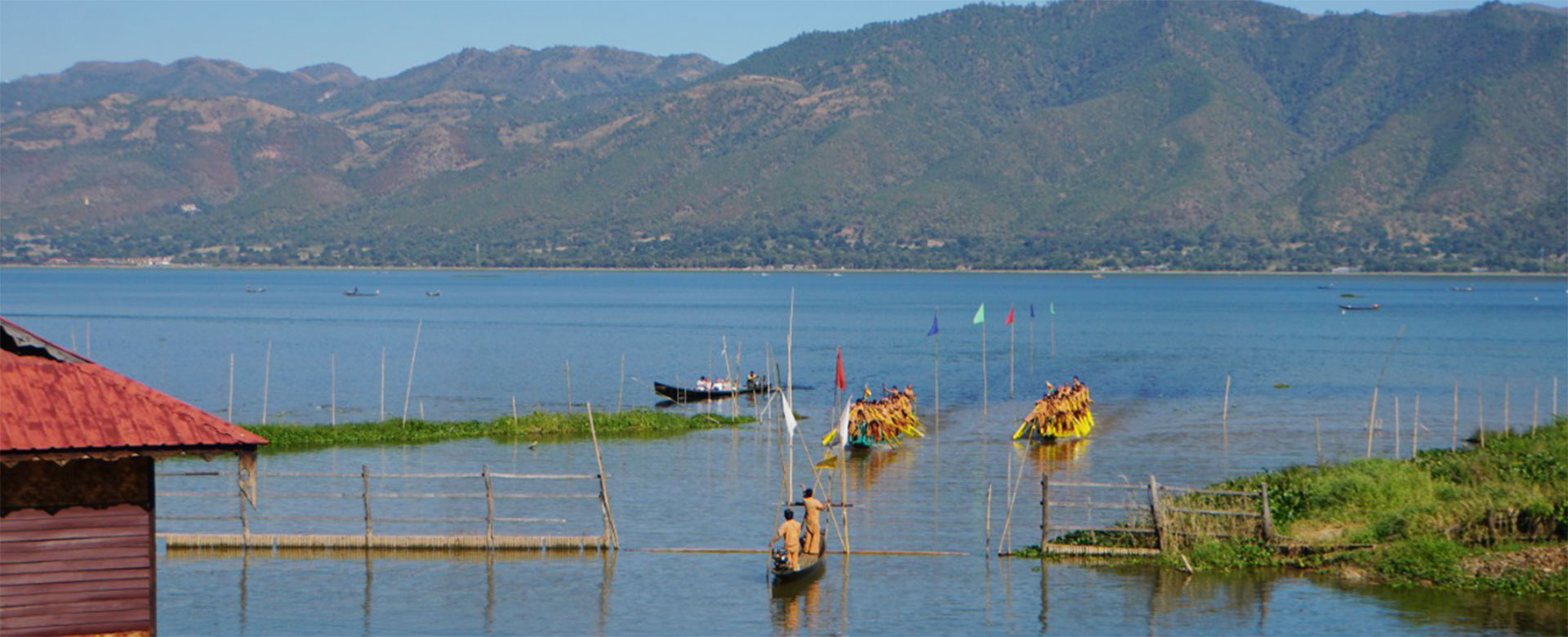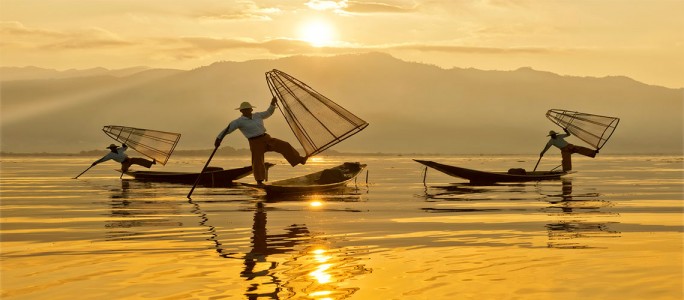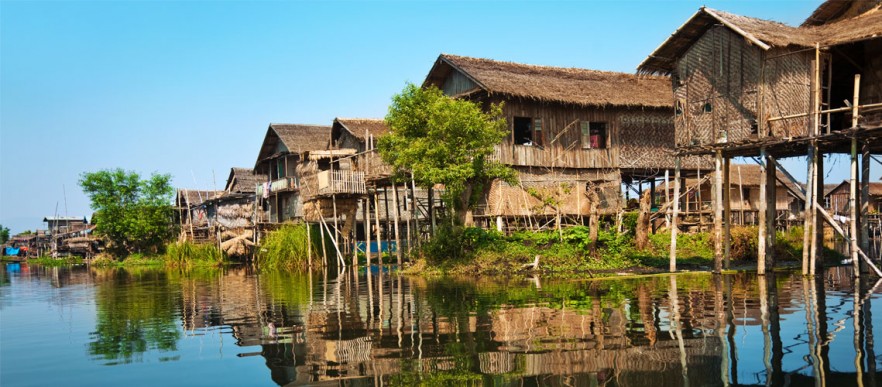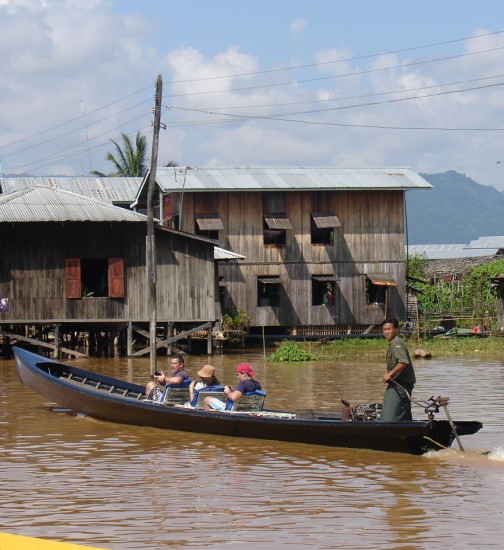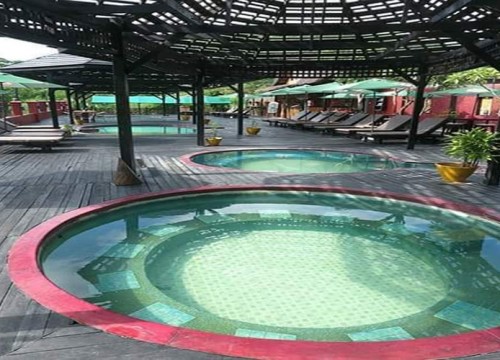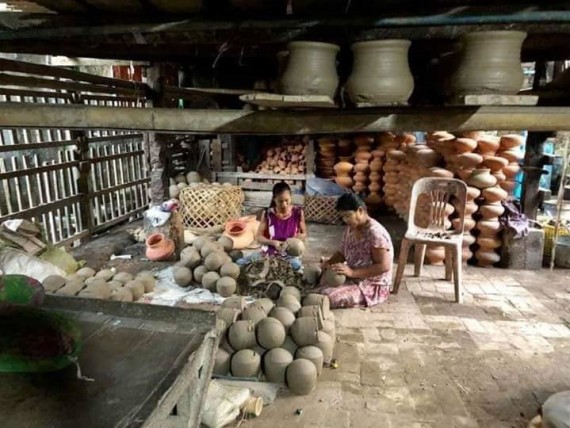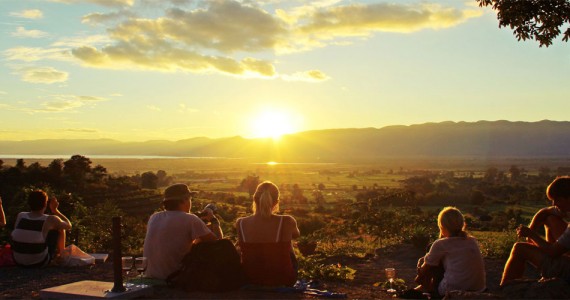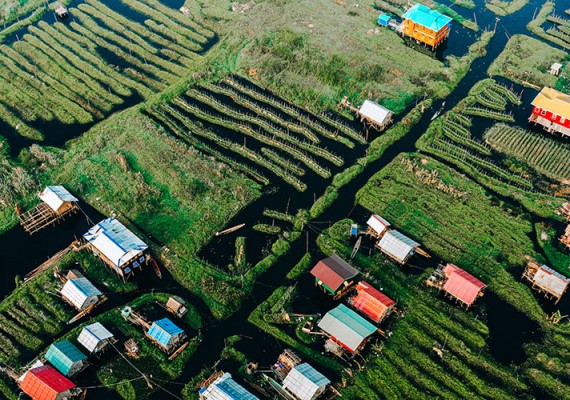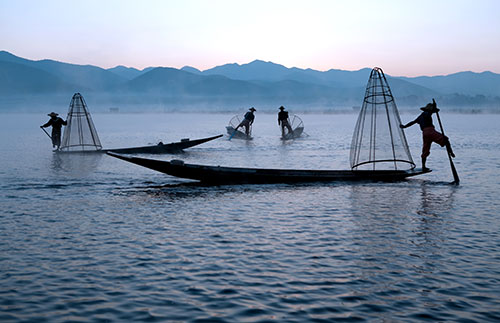
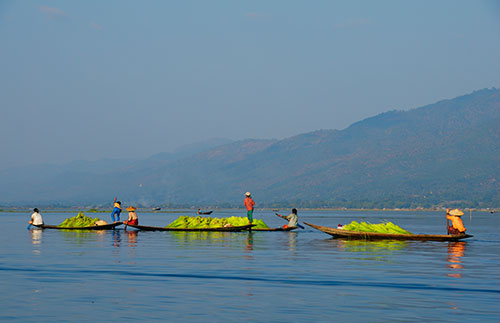
Introducing Inle Lake Region
The Inle Lake region is one of Myanmar's most anticipated destinations and located in the heart of the Shan State is the indescribable Inle Lake. It is the second largest freshwater lake in Myanmar and is approximately 900 meters above the sea level, Picture a vast, serene lake – 22 km long and 11 km across, & it is outrageously beautiful above sea level.
Inle Lake a large shallow lies in the cool green highlands of the Shan State, an area of outstanding natural beauty and cultural interest. The culture of the people is not like the rest of the country, and they have preserved their customs and way of life for hundreds of years. The inhabitants of the lake are called the "Inntha" means ( People from the Inle Lake ) the native lake dwellers, and their unique way of living will surely impress. Everything from rowing a boat to growing vegetables and fruit is unlike anywhere else.
Inle Lake, natural and unpolluted, is famous for its scenic beauty and the unique leg rowing of the Innthas, the native lake dwellers. High hills rim the lake on both sides. The lakeshore and lake islands bear 17 villages on stilts, mostly inhabited by the Inntha people.
For centuries, the Innthas have developed their own unique lifestyles on and around the shores of this beautiful lake. The Inntha built their houses over the water on stilts, floating island farm created from mud and reed dredged from the lakebed is extremely fertile and is mainly used for the cultivation of grow different vegetables from the region's most important cash-crop tomatoes to the flowers for their alters year-round on the one meter-thick floating islands formed by the weaving of dry grasses, hollow-stemmed weeds, and water hyacinth, then attached with the lakebed by using bamboo poles not to float away.
One of the first things you will notice on the lake is the fishermen. They have a very strange way of rowing their boats as they use their leg to assist in the work. Balancing on the tip of the boat the Inntha fishermen propel their handmade boats around the lake for work and pleasure. This minority tribe earns their fame for a unique way of catching fish with conical-shape fishing gear, and rowing the boat by standing at the stern of a slender boat, rowing with one leg! You will also witness the fishermen using strange cone shaped nets to catch various fish for their family as well as for the markets.
Their means of transport are small canoes they skillfully row with one foot while perched precariously on the other, and fishermen are seen at sunset and sunrise teetering on the sterns of their boats as they cast their nets over the waters. Once you've experienced the watery world that sits right by it and explored the environs of Inle Lake, that won't matter. Of all of the places you visit in Myanmar Inle will be the one you remember most fondly. The friendly hill tribe people, ancient pagoda's, colorful festivals and natural beauty will give you a life time of memories. Once you've experienced Inle you'll want to return again and again.
Shwe Yan Pyay & Shwe Yaunghwe Kyang Monastery
Just before entering the gateway town of Inle Lake, Nyaung Shwe, there's lie one of most impressive monasteries in Myanmar. A typical Shan monastery with unique oval-shape windows has quite an eye-catching appearance. The old beautiful teakwood monastery built in the early 19th century was richly decorated with glass mosaics, golden ornaments even on the supporting teak posts. While most of the people satisfy seeing from the outside, it is encourage taking a look at the cozy interior where the ceilings are beautifully carved and covered with gold leafs while the Shan-style lacquer images set in the middle on a plinth. The monastery is still in use and nearby stupa attached with a shrine also has an interesting story.
It is really interesting to be able to observe the young novice monks doing their recitation ( and homework ) in front of the Buddha Statue, the monks pray as it is a teaching monastery and the lighting from the oval windows made it even more special. If it isn't because of the famous oval windows it should be because it is a very small but special monastery.
The inside of the old building is also of interest, and don't forget the "New white sanctuary" next door, it also has some interesting old Buddha images and wall mosaics. When you walk around the outside look at the stumps and see the glass tilling that still remains. It's agelessly enchanting and very peaceful. Well worth riding out and next door in the small white pagoda Shwe Yaunghwe Kyang is a real treat, with the little alcoves inside and wonderful colors, so well worth heading out to these two for a visit.
The wonderful carved architecture monastery is worth the trip, if you have the time, and maybe stay a while because Shwe Yan Pyay Monastery is a must see gem near Inle Lake.
Ask our receptionist team to arrange it for you on your check out date since it takes about 15 minutes to observe and take beautiful photos on the way to Heho airport.

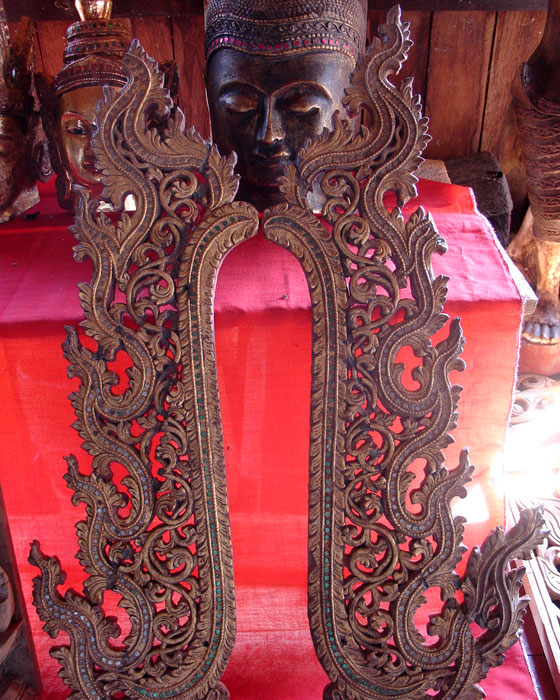
Introducing Nyaung Shwe & Shan Cultural Museum
This is the main town having direct access to Inle Lake via 6.4 km long canal and located at the north end of the lake. The town dated back to almost 12th century when the Sao Bwas ( Shan Chieftains ) ruled and controlled the entire rice-growing Nyaung Shwe plains.
The old Shan name for " Nyaung Shwe " is Yawnghwe. The " Yawnghwe Haw " ( Yawnghwe Palace) " is an interesting historic old Shan Palace exhibiting some interesting like royal throne & regalia of former Shan Sao Bwas, historic photos, Shan chronicles in Nyaung Shwe, displaying a large number of Buddha statues. It used to be called " Museum of Shan Chiefs " but it has been renamed to the " Shan Cultural museum " in 2015.
The town was once the capital of an important Shan kingdom ( this equal parts imposing and melancholy structure is the former palace of the last Saophas ( sky prince ) of Nyaung Shwe. Sao Shwe Thaike, who also served as the first president of independent Burma and who ruled here is now a museum ).
Today, the mostly empty building holds a few dusty displays and is worth visiting more for the stately brick-and-teak structure itself than any educational summary of Shan culture or history.
The town most revered Ratanar Maung Aung temple has unique glittering pinnacles, and has beautiful relief-molding works at the main entrance, as well as a good collection of religious antiques. The southern part of the town, along the canal, has some picturesque monasteries and keeps bustling every day. The town is an ideal place to begin bicycle tour to villages on the on the rim of the lake.
Market Day (5 Days Market)
Those travelling to Inle should visit the Five Day Market which takes place in villages and towns in and around the lake.
In Shan State, all the markets are not every day. We have 5-Day market its' means 5-Day rotation, from place to place once in every five days.
One of the most captivating events on the lake is the colorful 5-Day marketplace, where the hill-tribes of surrounding Lake Region come to exchange their goods with the Innthas. There are also endless souvenir stalls selling woodcarvings, colored beads, silverwares, woven products and various enviable items etc, which one could really hard to ignore. The bargaining is a must here.
In addition to souvenirs and gifts such as the brightly-woven Pa-Oh tote bags that you will see the majority of the people around Inle sporting, visitors will also be able to inspect handmade goods and tools that the locals use on a day-to-day basis.
Keep in mind that markets are not held on full moon days.
The 5-Day rotating market around Inle Lake offers a good opportunity to meet many different local tribes.
And the other reason, for Shan Chief is easy to collect the tax. The area is big and difficult to go from place to place. So on market day is easy to collect the tax. Thus, by the order of Shan Chief, they have 5-Day market in the region.
Inle Lake – Serene Morning
A good way of enjoying the quiet dimensions of Inle is to wake up early, before the agitation gain ground in and around the floating villages. This is also the best time of the day to witness the famous leg-rowers out on the quiet waters to catch early fish. An unforgettable experience for photo amateurs and early birds who wants to enjoy the luxury of having the lake for themselves. Unobstructed views on the open lake and the rolling hills of Shan State is all you need to start a day of sightseeing in a peaceful state of mind. Once the sun has risen, a tour of the stilt village at a gentle pace allows to truly catch the morning routine of the Innthas.
Witness the lake as one won't see it at any other moment of the day – completely quiet with only the fishermen conducting their daily business.
Great for photo amateurs: beautiful views with no other tourists.
An early morning tour, around the stilt villages to capture the morning routine of the villagers.
Please ask our receptionist to organize if you would like to have early morning tour.
Ancient Nga Phe Kyaung (or)
Jumping Cat Monastery in Inle Lake
(5 minutes boat drive)
Located close to the southern end of the main lake, nestled among the floating gardens of tomatoes and beans, is over 150-years old wooden monastery of Ngaphe-chaung constructed with teak. This Shan style monastery was built in 1843, by the order of Nyaungshwe Shan Sao Bwa, contains a very nice collection of northern Thai style image-houses as well as Shan inspired Buddha images made out of bamboo and lacquer and then gilded.
This attractive wooden monastery was built on huge pieces of teak wood with traditional architecture on stills of Inle Lake and renowned for its jumping cats. Century-old wooden sculptures can be seen there. A better reason to visit the pagoda is to see the collection of ancient Buddha images. Constructed four years before Mandalay Palace, the huge wooden meditation hall has statues in the Shan, Tibetan, Bagan and Innwa styles displayed on ornate wood and mosaic pedestals still can be seen in this monastery.
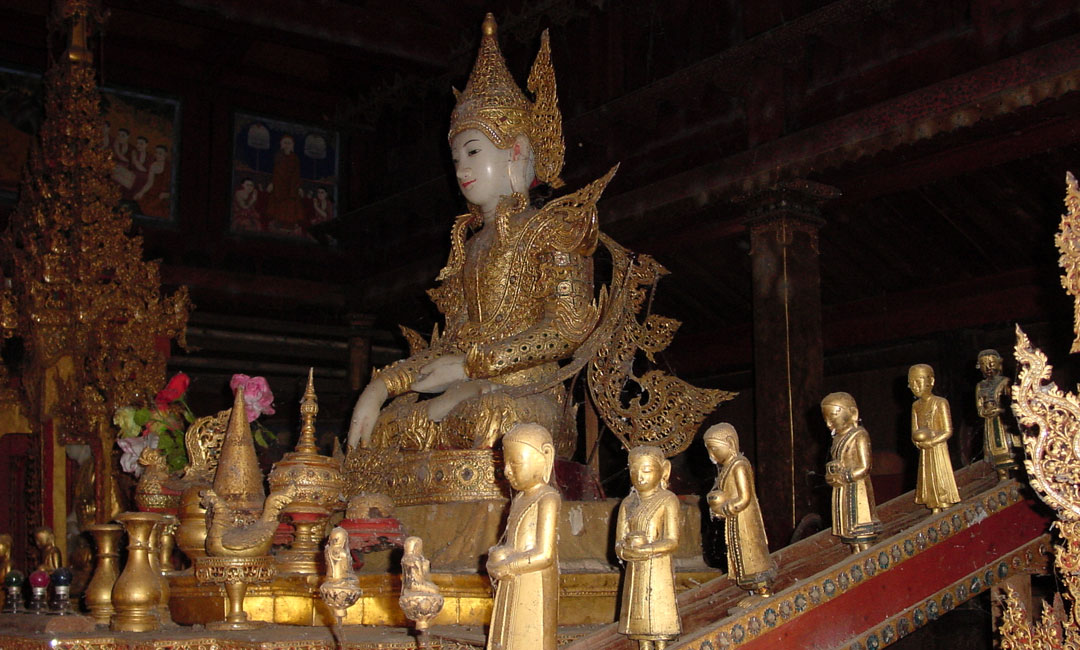
Kaylar - Village in Inle Lake
(10 minutes boat drive)
Kaylar is a fishermen village and situated on the north of Nampan that also has famous fascinating site to see many floating gardens where Inntha farmers grow squash fruits and vegetables year round, including tomatoes, beans, cauliflower, cabbage, eggplant, garlic, onions, melons, chili, banana and flower. The plants are grown on a marshy soil based mass that is extremely fertile and staked to the bottom of the lake with bamboo, on long wooden trellises supported on floating mats of vegetation. In the morning and afternoon, farmers paddle up and down between the rows tending their crops.
Ywama – Village in Inle Lake
(15 minutes boat drive from Hotel)
Ywama was the first and largest village on the Inle Lake to be developed for tourism and, as a result, the people at Ywama village tend to produce beautiful Inntha traditional silverwares, goldsmith, ancient artifacts, various products made from shan paper / umbrella industries and greatest number of souvenir shops. Its streets are a web of canals. Some beautiful teak houses built on large wooden piles driven into the lake bed. It's still a very pretty village, with winding channels lined with tall teak houses, but the charm can be diminished by the crowds of tourist boats and paddling souvenir vendors.
The main attraction at Ywama is the famous floating market, though this is a victim of its own success. Held once every five days, the market is a traffic jam of tourist boats and souvenir hawkers, with a few local farmers peddling vegetables in among the crowds. This is the place where you will see long neck Ladies.
It is the largest village on the lake with beautiful houses built on large wooden poles driven into the Lake Bed.
Phaung Daw Oo – Buddhist Temple in Inle Lake
(15 minutes boat drive from Hotel)
Phaung Daw Oo Pagoda's Festival – This is the most holy of all Shan state celebrations. Once a year, in late September - early October, during the month of Thadingyut October, total 18 days of Pagoda festival is held depending on the Myanmar traditional lunar calendar. Festivals in Myanmar mostly coincide with the full moons days and often related to Buddhism, during which four of the five Buddha statues at Phaung Daw U Monastery are placed on a replica of a royal barge designated as a Hintha bird ( the golden Swan of Burmese legend ) and taken throughout Inle Lake, stopping at village for people to pay homage. One image always remains at the temple. The most interesting event of this festival is the leg-rowed boat races and it is the one and only place in the world that boat races are participated by thousand of leg-rowers follow the procession. The large crowds of people gather on the lake-shores to celebrate the occasion.
Local families often bring their children here as part of the ordination rites for the Sangha ( Buddhist brotherhood ) – a fascinating spectacle if you happen to be there at the right time.
Boat races are held during this festival. In some boat races, each boat carry, over one hundred people each, standing upright and rowing with their legs in the traditional Inle style. Local and foreign visitors are crowded at such a time.
A wide channel leads south from Ywama to the village of Thar Lay and Phaung Daw Oo Paya, the holiest religious site in Southern Shan State. Enshrined within the huge tiered pagoda are five ancient Buddha images that have been transformed into amorphous blobs by the sheer volume of gold leaf applied by devotees.
This is mainly because of the ceremonial Phaung Daw Oo Festival, the most important event held there. The Inntha and Shan folks wear new clothes to celebrate the end of Buddhist Lent, or " Waso ". The festival is full of pageantry and colourful, and there are fun fair, music, dances and boat races participated by both women rowing with their legs. It is one of the most dazzling, splendid sight and magical places in Asia.

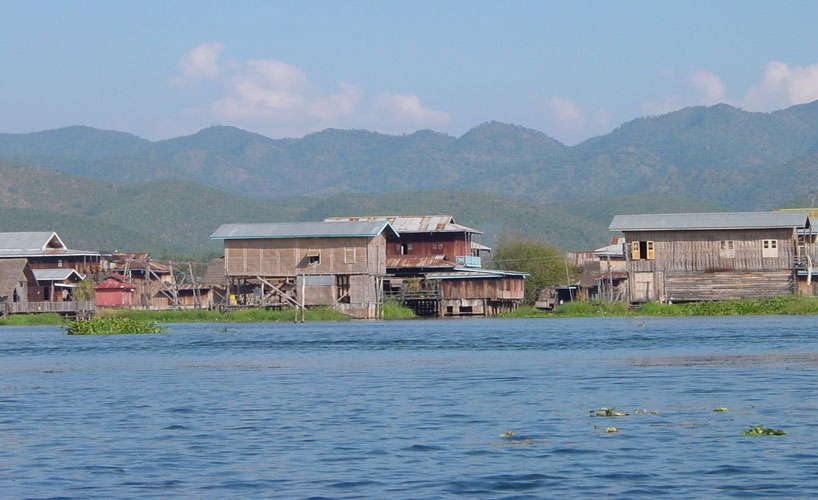
Nampan - Village in Inle Lake
(20 minutes boat drive)
The peaceful village of Nampan is built on stilts over the water. Its main temple, Alodaw Pauk Pagoda, is one of the oldest shrines on the lake, and the whitewashed stupa enshrines a fabulous gem-encrusted, Shan-style Buddha.
Nampan has several small Cheroot factories, Boat making, Shan traditional bas-relief molded lacquer-ware and some decent restaurants on the edge of the village.
Hseikhaung Village (Se Gaung)
(30 minutes boat drive)
Famous of making blacksmith workshop such as knives, scissors, etc.


Inn Paw Khone - Village in Inle Lake
(30 minutes boat drive)
This very attractive & seductive tidy village of teak stilt houses is famous for Shan-styled Lotus robes especially Lotus, Silk & Cotton weaving workshops and fiber woven products by hand. Buildings across the village vibrate with the clatter of shuttles and the click-clack of shifting loom frames, and the workshops are a popular stop on the tourist circuit.
Shwe Inn Dein(35 minutes boat drive from hotel)
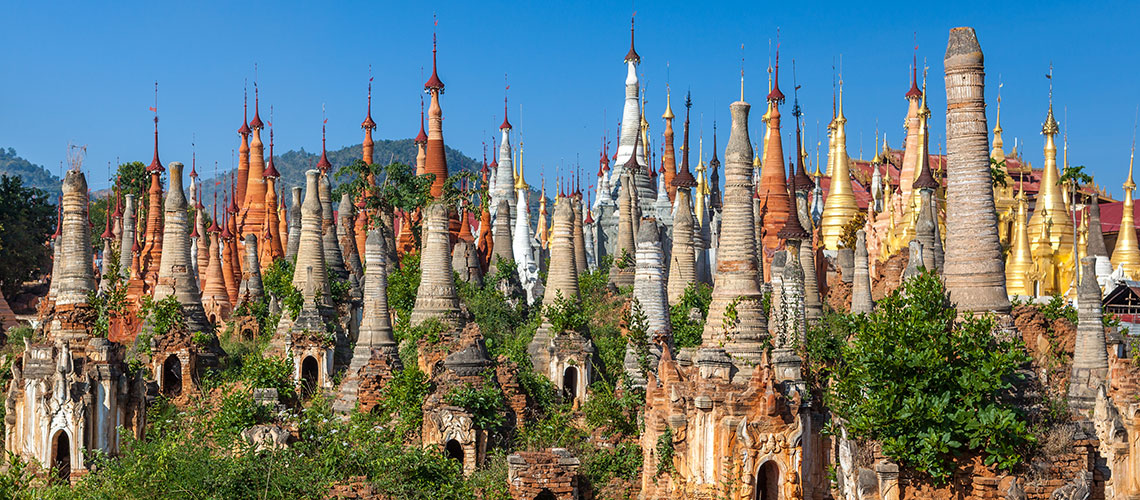
It is one of the small villages of Inle Lake located on the southwestern shore of the main lake.
Nyaung Oak ( under the shade of Banyan trees ) Monastery has a nice, old moldering complex of shrines and stupa at the bottom of the hill. At the top is Shwe Inn Dein reached by a long stairway with over 400 wooden columns.
Inn Dein village area can be said the most scenic part of Inle Lake. The creek leading to the village is beautiful at all seasons, animating with different activities on its banks. Inn Dein village serves as the main western portal to the lake for nearby Pa O villages on the hills.
A Buddha image has enshrined at a whitewashed stupa, which is on the summit of a hill. Below the stupa around the hill are cluster of hundreds of ancient stupas most are ruins overgrown with bushes.
This mysterious place is at the end of the marvelous Inndein creek, which connected with Inle Lake just after the Phaung Daw Oo Pagoda. The creek is narrow with many twist and turns. Since the both sides are paddy fields you can see the farmers ploughing and harrowing by water buffaloes. At the lunch time while groups of farmers having lunch the water buffaloes enjoy themselves dipping in the creek. At many places in the creek the farmers dam up the water by bamboo barriers to irrigate the paddy fields. Inndein water is not only useful for irrigation also for bathing and washing clothes. It is compulsory to see Novice monks, buffalo boys and village girls wash and swim in the creek.
The pagoda hill is quiet and calm. One could feel the pleasant cool breeze with the sweet rings of the bells hanging at the umbrella of the stupa. Mesmerizing great views from pagoda across the lake to the hill release the fatigue and refresh everybody who ascends to the peak.
The quaint village of Inndein on the western side of the lake is accessed by a winding river that is too shallow to use late in the dry season.
It will take a 45 minute boat ride. The pagoda and stupas built in the 18th century and rows of shops are famous.
Maing Thauk Village
(20 minutes boat drive)
On the eastern side of the lake, the village of Maing Thauk has a split personality half the village is set on dry land, while the other half sits on stilts over the water, linked to the shore by a 450 meters wooden bridge. A large and bustling market where you can find a real local atmosphere with a variety of produce from the lake.
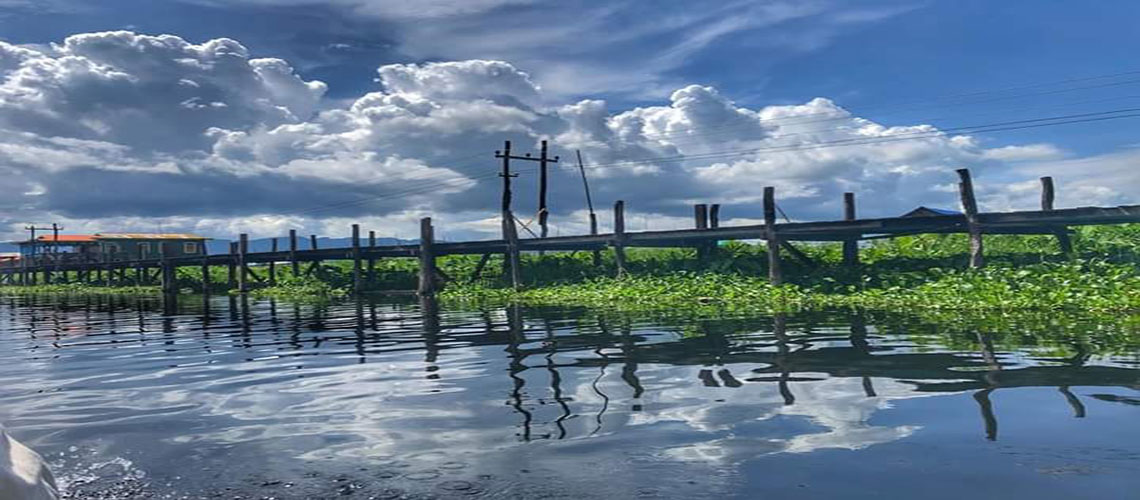
Hot Spring & Tofu in Khaung Daing Village
Located on the northwestern shore of the lake 20 minutes boat drive from the hotel. Khaung Daing is a quiet Inntha village. It's known for its Tofu, Soya related food stuffs prepared using split yellow peas instead of soybeans. The village and shown how numerous types of food were made by hand using traditional methods and real village life in action.
Hot Spring open 06:00 to 18:00, where hot water directly from the nature springs without any treatment has been channeled into a swimming pool and a series of private bathhouse for men and women.
Khaung Daing is the native village on the northwestern shore of the lake. It is known for its production of soybean cakes and noodles. There are some interesting Shan Buddhist monuments just outside the village. A little north of Khaung Daing is a hot spring where you can take a bath.
Probably a good stop over if you are exploring ( by bicycle ) while completing the loop ( Hotel >>Khaung Daing>>Maing Thauk ).
Kyauk Taing Village
(1 hour boat drive)
To view the pottery and various vases making factory.
The Lost Treasures of SAGAR Lake
(3 hours boat drive – full day)
A long canal at the bottom of Inle Lake winds south through peaceful countryside to a second lake ringed by Shan, Inntha and Pa-Oh villages that people produce rice-alcohol and can see the old village is under the water.
It was formerly located on the hills, but after the construction of the water supply, the village was moved and the temples are still remain there. There are hundreds of Buddha Images in sitting, standing & reclining positions, which are supposed to be over seven hundred years old. The boat excursion towards Sagar, the landscapes on the way make emotions and delights to be there.
The route to Sagar is in itself a journey of enchantment. The boat weaves through waters of Inle and down South. It can be done day trip by boat, commencing at Inle, to Sagar will take approximately 3 hours, Further south, travelling along the canals that connect Inle and Sagar.
Sagar is a ruined royal capital with ancient monasteries and pagodas at the southern end of Inle Lake.
If you are interested to explore the two Winenaries --
Red Mountain
(16 minutes by car from Nyaung Shwe 5.4 km)
Located on the side of the famous Inle Lake, in a valley just outside Nyaung Shwe, the Red Mountain Estate produces the best wines of the country. Since the beginning, the wines are produced with locally grown grapes. All of the 400,000 plants have been imported from France and Spain, and the variety chosen after experimentations.
It's a combination of different factors, the cool climate, the soils, the long experience of our French winemaker. The wines are made in the tradition of western wines with all new technologies and modern equipments."
Myanmar Vineyard
(36 minutes by car from Nyaung Shwe 21 km)
"Aythaya Red" is a cuvée from Shiraz ( Syrah ), Dornfelder from Germany and Tempranillo grapes from the Rioja Valley in Spain. The original vines were imported in 1999 from France, the result of our intense research period. Another discovery was that from nearly 100 classic varieties only 6 cultivars withstood the challenges of the tropical environment. The vineyard is located at Aythaya and sits at an elevation of 4290 ft on well-watered, limestone-rich soils, providing good growing conditions for Shiraz, Cabernet Sauvignon, Sauvignon Blanc, Chenin Blanc and Moscato grapes.
A fruity red Moscato grape from Italy is the main grape variety of the famous "Aythaya Rose´". The noble Sauvignon Blanc from the Bordeaux area and Loire Valley is the dominating grape variety of our "Aythaya White".
Kakku Pagoda
(2 hours by car, 75 kilometers from Nyaung Shwe)
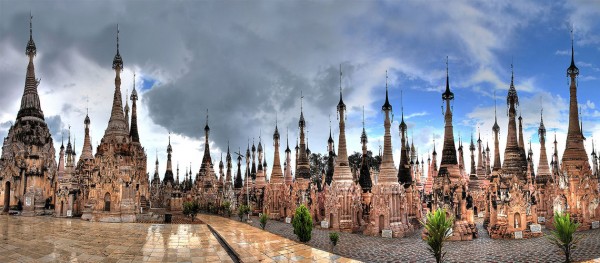 Just a couple of hours from Taunggyi, discover the "long lost" ruins of Kak Ku in countryside inhabited by the Pa-Oh people. Situated in the rolling Shan Hills, Kak Ku pagoda is very unusual and little is known about its origins. The Pa-Oh people believe that the original pagoda was built on the site some 2,000 years ago. Dozens of small stupas surround the main pagoda in a huge circle. You can wander through the stupas which are decorated with fine stucco work and Buddha images. The tranquility and peacefulness provide the site to be visited and above all, the hill tribes living nearby, Pa-Oh is additional attraction of the place.
Just a couple of hours from Taunggyi, discover the "long lost" ruins of Kak Ku in countryside inhabited by the Pa-Oh people. Situated in the rolling Shan Hills, Kak Ku pagoda is very unusual and little is known about its origins. The Pa-Oh people believe that the original pagoda was built on the site some 2,000 years ago. Dozens of small stupas surround the main pagoda in a huge circle. You can wander through the stupas which are decorated with fine stucco work and Buddha images. The tranquility and peacefulness provide the site to be visited and above all, the hill tribes living nearby, Pa-Oh is additional attraction of the place.
One of the Asia's largest and most spectacular ancient monuments is a wonderful Pagoda named Kak Ku Pagodas are a group of over 2,000 stupas. Most of them are many centuries old, and it is a newly opened destination.
When Myanmar opened its doors to the outside world in the early 1990s, both many spectacular natural and man-made discoveries came to light to both the locals and the tourists. To discover places like this, such as the Kak Ku Pagoda Complex, seems almost like a miracle.
Green fields stretch for miles on each side of the road. A long row of tall, thick-leafed trees, in pairs, disappear over the far hills: it is a shady road with trees planted by a monk to connect his village to a pagoda at the other end. A turn in a corner into a valley leads you straight to this wonderful sight of thousands of small pagodas clustered close to each other, surrounding a bigger spire set on a rise. The pagodas are decorated with floral designs or figures of celestial beings or bird-men climbing up the sides, created out of stucco. Everything is still the huge trees nearby cast their shades on bees and butterflies fluttering in the meadows.
Kak Ku is in the territory of Pa-Oh people. There are over 2000 stupas packed closely together in ranks and covering an area perhaps a square kilometer. The main stupa is around 40 meters high, the mass of the spire surrounding it uniformly. But each one is an individual masterpiece. The particular remarkable about the whole site is its good state of preservation. Originally each one must have been topped by a gilded metal hti, the multi tiered umbrella-like feature, which is typical of Myanmar
Pagodas. Many of these are tilted on fallen. External rendering of mortar and stucco has crumbled away on others, exposing the brick core while trees have established themselves in a few, threatening to split them apart. But so much of the originals still exist that this site must be free of the destructive force of earthquakes, which have periodically ravaged many of the Myanmar's other monuments.
Every year, Kak Ku Pagoda Festival celebrated three days in March before the Full Moon of Tabaung by the Myanmar lunar calendar. The Kak Ku Pagoda Complex may have been only recently discovered by the outside world but for centuries the shrines have been the personal, intimate place of worship for the Pa-Oh people called Kak Ku Mway Daw Pagoda, believing that a holy relic of the Buddha Gautama was enshrined under the main spire celebrate the pagoda festival, and tens of thousands of pilgrims come from all over the region, by cart, by walking through the woods. Hundreds of monks gather to recite the sutras on the morning of the Full Moon Day which is attended by thousands of devotees.
Kak Ku is a priceless piece of mankind heritage, a truly splendid example of the creative talent of remarkable people.
Pindaya Cave
(1 hour and 40 minutes by car, 72 kilometers from Nyaung Shwe)
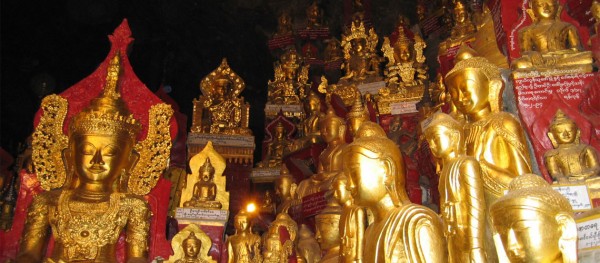 Pindaya is located north of Inle Lake and Heho, the Shan State airport town, a lot of beautiful landscape and countryside of magnificent scenic beauty to be taken in when travelling to Pindaya makes a good escape from the tourist crowds and hustle of Inle Lake. It is a small quiet town perched on the bank of the placid Botoloke Lake is another popular attraction at Pindaya. It is a huge cave where hundreds and thousands of Buddha images in various size and shape are donated and installed since the 11th century. The most attractive place in Pindaya is the ancient Shwe U Min cave ( a massive limestone cavern ) which contains about 8,000 Buddha statues created by devotees which are collected over the centuries and its has a length is 149 m long. All the sculpture work, carvings and paintings inside these caves are of Lord Buddha and were created by hand by his worshippers.
Pindaya is located north of Inle Lake and Heho, the Shan State airport town, a lot of beautiful landscape and countryside of magnificent scenic beauty to be taken in when travelling to Pindaya makes a good escape from the tourist crowds and hustle of Inle Lake. It is a small quiet town perched on the bank of the placid Botoloke Lake is another popular attraction at Pindaya. It is a huge cave where hundreds and thousands of Buddha images in various size and shape are donated and installed since the 11th century. The most attractive place in Pindaya is the ancient Shwe U Min cave ( a massive limestone cavern ) which contains about 8,000 Buddha statues created by devotees which are collected over the centuries and its has a length is 149 m long. All the sculpture work, carvings and paintings inside these caves are of Lord Buddha and were created by hand by his worshippers.
It's a good centre for walks into the surrounding hills, but it also has a popular tourist attraction. Pilgrims arrive in a slow but steady steam, installing new images and meditating in tiny meditation chambers formed by natural cavities in the cave walls. Some of the smaller caves used meditation chanmers are accessible only if you crawl in on your knees and elbows.
There are certainly lots of Buddhas in there but the caves also feature a recreation of a local legend about a heroic prince saving helpless damsels from the giant spider with his trusty bow and arrow. Images of that nasty spider pop up all over town including a fine model of spider and prince at the entrance to the cave.
The main annual Paya Pwe ( Pagoda Festival ) at Shwe Oo Min takes place on the full moon of Tabaung in March. Expect all the usual singing, dancing and hand-operated fairground rides.
A pagoda festival is celebrated at the base of Pindaya Hill which is lined with huge banyan trees. One of the villages of Danu is known as Hgnatpyawtaw and is a popular tourist destination & interesting to observe their cottage industry. At the base of Pindaya Hill is Singaung Monastery, a century old teakwood building which also has a lacquered-bamboo Buddha image.
Huge monastery compounds with numerous pagodas and temples in different stages of dilapidation are much respected by such ethnic groups as the Shans, Danus and Pa-Oh living in the environs of Pindaya.

